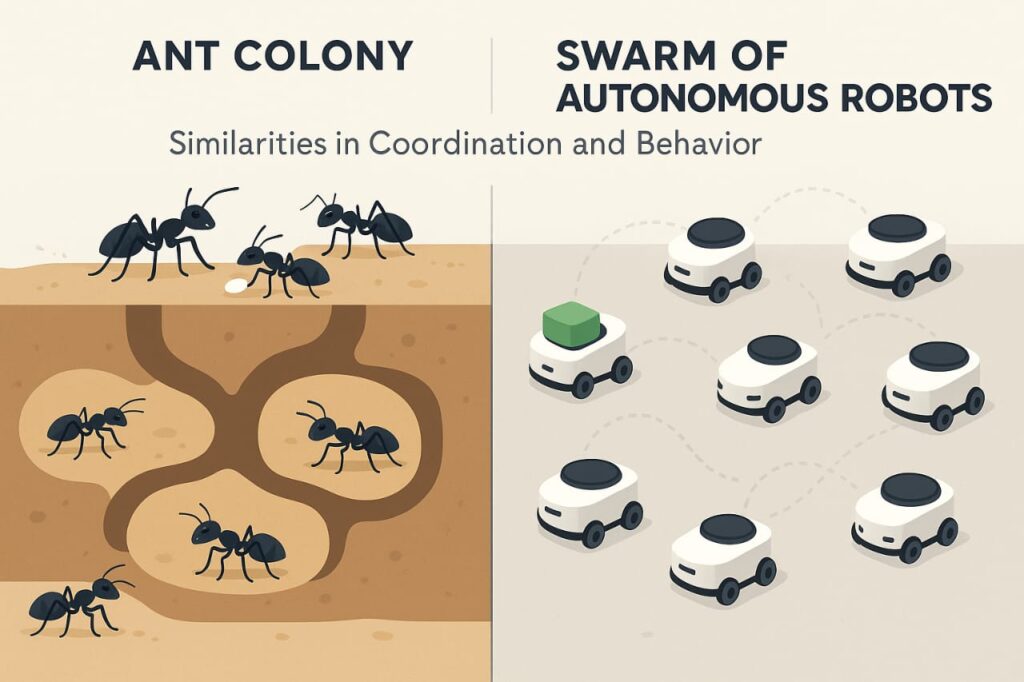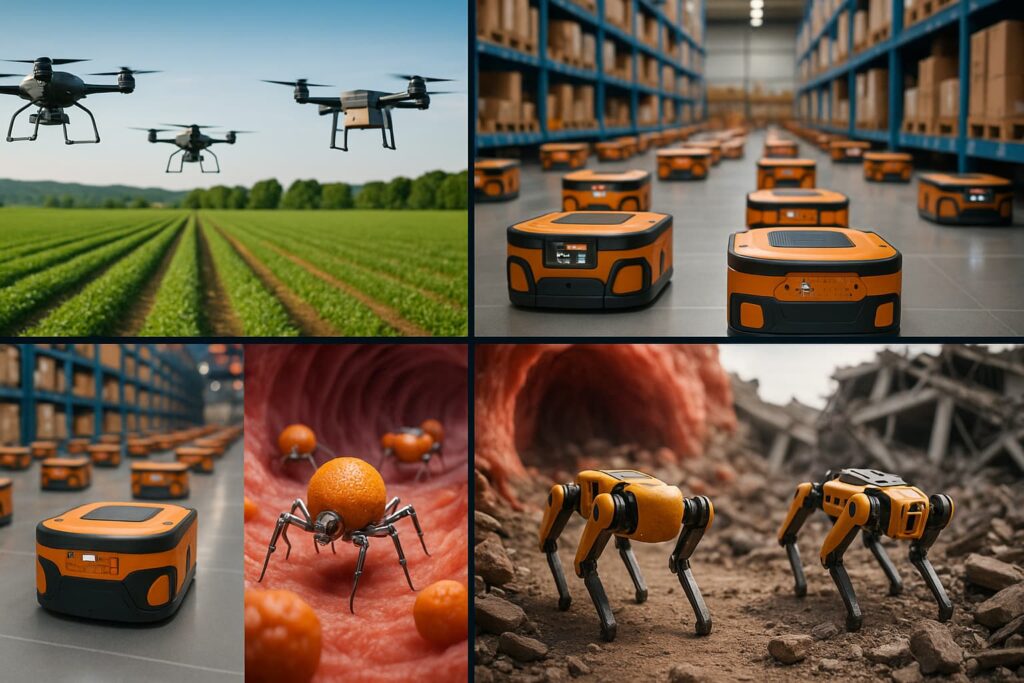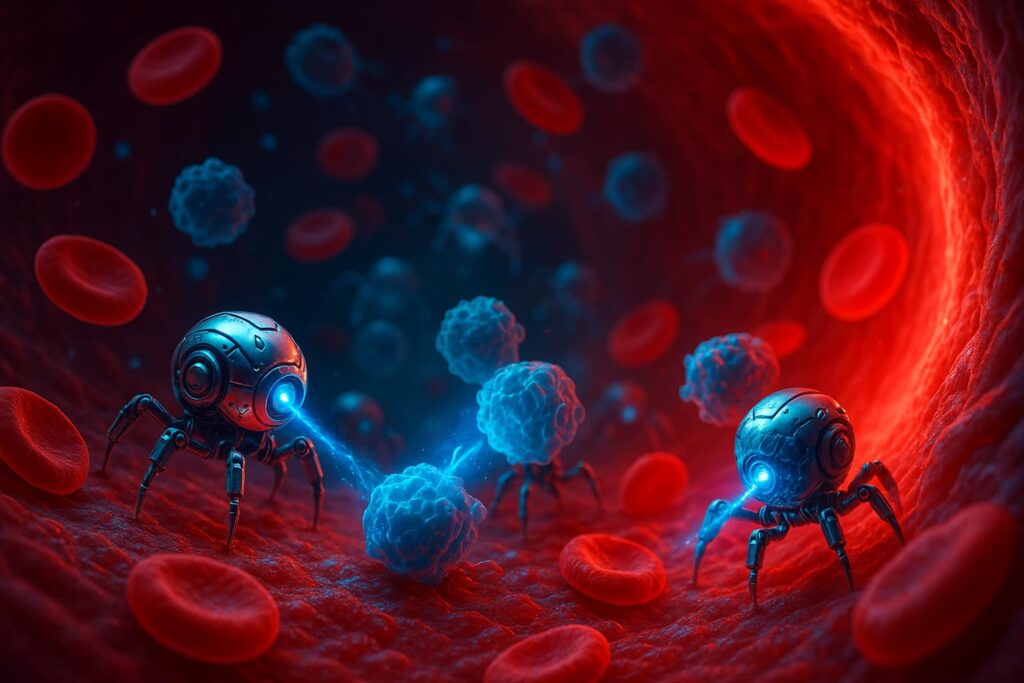Introduction
Imagine a future where thousands of tiny robots collaborate seamlessly, like an ant colony, to build structures, manage crops, conduct search-and-rescue missions, or even heal the human body from within. This isn’t science fiction—it’s the emerging field of swarm robotics, a subdomain of robotics inspired by nature and powered by AI, sensors, and distributed algorithms.
Swarm robotics involves the coordination of large numbers of relatively simple robots that operate autonomously but communicate locally to perform complex tasks collectively. The beauty of this system lies in its decentralization, scalability, and resilience. Let’s explore how this futuristic concept is already revolutionizing key industries and what the future holds.
What Is Swarm Robotics?
At its core, swarm robotics draws inspiration from biological systems—think ant colonies, flocks of birds, or schools of fish. Each individual in these systems follows simple rules and communicates only with its neighbors, yet the group collectively achieves sophisticated goals.
Similarly, swarm robots are:
- Individually simple and inexpensive
- Designed to cooperate using local communication (like Bluetooth, infrared, or Wi-Fi)
- Able to adapt and self-organize without centralized control
This decentralized design means that the system is fault-tolerant—if one robot fails, others can continue the task. It also makes the swarm highly scalable, allowing the addition or removal of robots with minimal disruption.

How Swarm Robotics Works
Swarm robotics relies on three foundational principles:
1. Local Perception and Communication
Each robot senses its environment and communicates with nearby robots. This avoids the need for a global map or central coordinator.
2. Simple Rules, Complex Behavior
Just like birds following a few rules can form a beautiful flock, swarm robots use simple behavioral algorithms to create complex group dynamics. For instance, robots might follow rules such as:
- Move toward light
- Stay close to other robots
- Avoid obstacles
3. Distributed Decision-Making
There is no leader in the swarm. Decisions are made collectively and dynamically, leading to a high level of adaptability and robustness.

Applications of Swarm Robotics
Swarm robotics is not just a cool concept—it’s already being tested and implemented across various fields:
🏭 Manufacturing and Warehousing
Companies like Amazon have pioneered the use of swarm robotics for warehouse automation. Small bots move along warehouse floors, transporting goods and optimizing storage. Swarms improve efficiency, reduce human error, and can operate 24/7.
🌾 Agriculture
Swarm drones can be used to monitor crops, distribute fertilizers, and detect diseases. Their ability to cover large areas quickly and coordinate with each other makes them ideal for modern precision agriculture.
⛰ Search and Rescue
In disaster scenarios, swarm robots can enter dangerous environments—collapsed buildings, fires, or flooded zones—to locate survivors. Their small size allows them to access hard-to-reach places, and collective mapping helps navigate complex terrain.
⚖ Defense and Surveillance
Military applications include drone swarms for reconnaissance, surveillance, or even coordinated strikes. These systems are harder to detect and more resilient than traditional large-scale drones.
🏥 Healthcare
On the micro or nano scale, researchers are developing swarm microrobots that can navigate the human body to deliver drugs, clear blockages, or perform micro-surgeries. Though in early stages, this could revolutionize medicine.

🚀 Space Exploration
NASA and other agencies are exploring how robotic swarms could explore planetary surfaces, collect samples, or build infrastructure on the Moon or Mars. Swarms offer redundancy and flexibility crucial for deep-space missions.
Benefits of Swarm Robotics
- Scalability: Easily add more robots without needing to reprogram the system
- Fault Tolerance: System continues to work even if individual bots fail
- Flexibility: Adapt to new environments and tasks
- Cost-Effective: Simple robots are cheaper than large, complex machines
- Autonomy: Operate with minimal human intervention
These benefits make swarm robotics an attractive solution across diverse sectors.
Challenges Facing Swarm Robotics
Despite the promise, several hurdles remain:
🧨 Communication and Coordination
Ensuring smooth, real-time communication among hundreds or thousands of bots is a technical challenge, especially in environments with signal interference.
🔒 Security and Privacy
Swarm systems could be vulnerable to hacking or manipulation. A compromised swarm could cause significant damage, particularly in defense or healthcare contexts.
🔁 Energy Efficiency
Tiny bots have limited battery life. Energy-efficient design and wireless charging systems are areas of ongoing research.
🚧 Ethical Concerns
Military use, surveillance, and job displacement are key ethical issues. Clear policies and responsible deployment are essential.
The Future of Swarm Robotics
The next decade is likely to see rapid advancements in swarm robotics, driven by developments in:
- AI and machine learning (for better coordination)
- 5G/6G networks (for faster communication)
- Miniaturization (to build smaller, more powerful bots)
- Autonomous systems and edge computing
Startups and academic labs are leading the way, but major players like Google, Amazon, and Lockheed Martin are also investing heavily. As the technology matures, we can expect swarms to become an everyday part of logistics, security, agriculture, and beyond.

Conclusion
Swarm robotics represents a new era of automation, where collaboration, adaptability, and intelligence emerge from simplicity. These tiny bots, inspired by nature but powered by cutting-edge tech, are already transforming industries and reshaping what we thought was possible.
From warehouses to war zones, from farms to the human bloodstream—swarm robotics is not just the future. It’s already here, and it’s just getting started.
“In the future, it may not be massive machines that define power, but millions of tiny ones working in perfect harmony.”
Swarm Robotics Overview
👉 Learn more about swarm robotics from MIT’s Computer Science and Artificial Intelligence Laboratory (CSAIL).
Warehouse Automation with Swarm Robots
👉 Amazon’s use of swarm bots is covered in detail in this article by Robotics Business Review.
Agricultural Drone Swarms
👉 Explore how swarm drones are transforming precision agriculture in this scientific study.
Swarm Robotics in Disaster Response
👉 Read about real-world disaster simulations using robotic swarms in this IEEE Spectrum report.
Healthcare Applications of Microrobots
👉 For insights into medical swarm bots, see this Nature article on microrobotic drug delivery.



